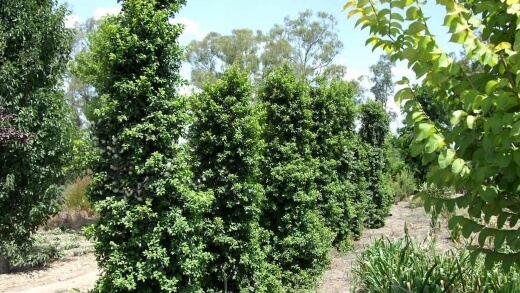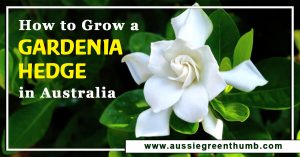Hedges are a great alternative to privacy fences. Along with privacy, they can help protect you from the wind, and they attract wildlife. If you are interested in installing a hedge, it is important to do your research first.
Taking the time to do your research will help ensure you buy the best hedge plants for your project.
More...
How to Choose the Best Hedging Plants
Hedge plants are used to add to the aesthetics and create privacy. Although many people think they can use any hedge plant, this is not the case. Hedge plants are all different and each has special requirements.
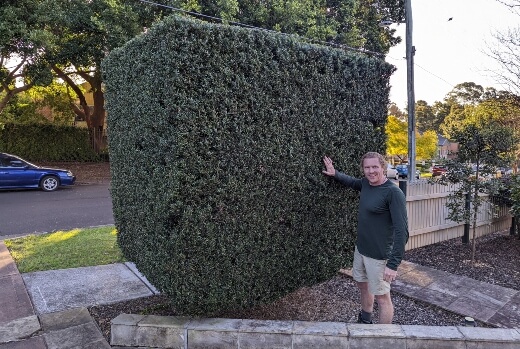
Nathan Schwartz of Aussie Green Thumb standing beside a well maintained hedge
Things to Consider Before Buying Hedge Plants
- Sun Exposure - How much sun will the hedge plants get? Some plants require full sun, while others can tolerate some shade. Before you buy your plants, pay attention to the amount of sunlight the area actually gets.
- Height - Do you need hedging plants that will get really tall? Or are you in need of plants that only get a metre tall? Check to see how tall the plants will get when used as hedging shrubs.
- Width - How wide do the plants get? You will need to know this to determine how far apart to plant them.
- Density - Do you want a hedge that is thick and hearty? Or are you looking for a hedge that is airy? A fuller hedge can add more privacy. They can also be good choices for shaping.
- Shape - Are you looking for hedging plants you can shape? Or do you want plants that have a natural look? Some plants have natural conical, round, or mound shapes. While others can take a bit of work to tame.
- Flowers - Do you want a hedge that flowers? Flowers can add to the beauty of the hedge, and they attract pollinators. However, the petals do fall off creating a mess, and some people are allergic to bees.
- Soil - What type of soil do you have? Hedge plants have special soil requirements. If you plant them in the wrong soil, they can die or look very shabby.
- Time - How quickly do you need your hedge to become established? Some plants can grow rather quickly. While some can take years to reach full size.
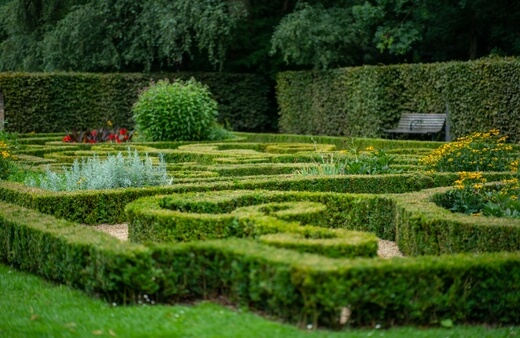
- Maintenance - How much maintenance do the hedging plants require? If you love getting outside and working in your garden, you may not mind performing regular pruning, watering, and fertilising. If you do not like garden work or do not have the time to do it, look for plants that demand very little of your time.
- Native Plants - Another thing you will want to think about is whether you want native plants. Just because the hedge plants will grow in your area does not necessarily mean they are native to your area.
- Pests & Diseases - Garden hedges are susceptible to pests and diseases. It is important to know what the plants are vulnerable to. This way you can treat the plants before they are affected.
- Location - Where do you want to install the garden hedges? Are you positive the area is on your property? You do not want to plant a hedge only to start an argument with your neighbours. You also need to know where any electrical lines and other utility lines are located.
- Cost - Hedging plants can vary in price. And the more you need, the more you will have to pay. Always sketch out your plant and determine the exact number of plants you need. Remember, plants grow to different widths. So, you will have to determine how closely they need to be placed together.
Top 20 Hedging Plants in Australia
1. Syzygium ‘Cascade’ (Syzygium luehmannii x Syzygium wilsonii)
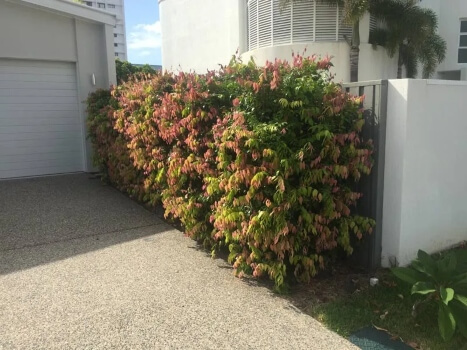
Source: Hedging and Screening
The Syzygium ‘Cascade’ grows in full sun to partial shade. Its textural foliage is green with bright pink new growth. The plant features beautiful pink flowers and pink fruit. These hedge plants require minimal pruning.
They will look full and neat with only one or two trimmings a year. The Syzygium ‘Cascade’ thrives in rich, well-drained soil. Once established, it can even survive drought periods. It will not tolerate waterlogged soil. The hedges need moderate watering.
Syzygium ‘Cascade’ hedging plants will grow fast in the right conditions. They can grow up to 3-4 m high by 2-3 m wide.
2. Brazilian Red Cloak (Megaskepasma erythrochlamys)
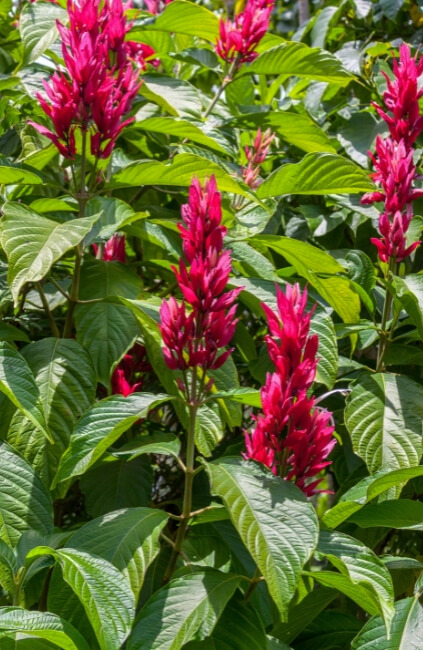
The Brazilian red cloak will grow in full sun and full shade. It has a tropical look and large, mid-green leaves. The hedging plant features eye-catching bright red flowers that appear periodically throughout the year.
With regular, light pruning, Brazilian red cloak hedging plants will stay small and dense. Using a high-quality fertiliser several times throughout the year will create a strong plant with fast growth.
Although the plant can grow in full sun and full shade, it has a nicer green colour in partial sun. It will flourish in rich, well-drained soil. It does not tolerate waterlogged soil. It requires moderate watering.
3. Mock Orange (Murraya paniculata)
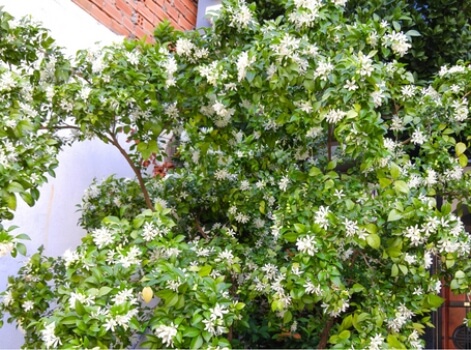
The Mock Orange will grow in full sun to partial shade. It has dense, dark, tropical foliage that is ideal for hedging. It features fragrant white flowers in the spring and late summer. However, this hedging plant usually has a few flowers all summer long.
These plants must be pruned every 2 to 3 months. Light pruning during the growing months will encourage vigorous, dense growth. If mock orange plants are not pruned, they will become small trees.
Mock orange plants can grow in partial shade. They look best and are fuller when grown in full sun. The plants do well in rich, well-drained soil. They will not grow in waterlogged soil. They need low to moderate watering.


Get Your Free Guide:
Master Growing Australian Natives eBook
A Must Have Complete Guide for Every Australian Garden
Get Your Free Guide:
Master Growing Australian Natives eBook
A Must Have Complete Guide for Every Australian Garden
Murraya paniculata will grow fast in the right conditions and can grow up to 3-4 m high by 3-3 m wide. Even though they can grow tall, they can be restrained by pruning.
4. Woolly Bush (Adenanthos sericeus)
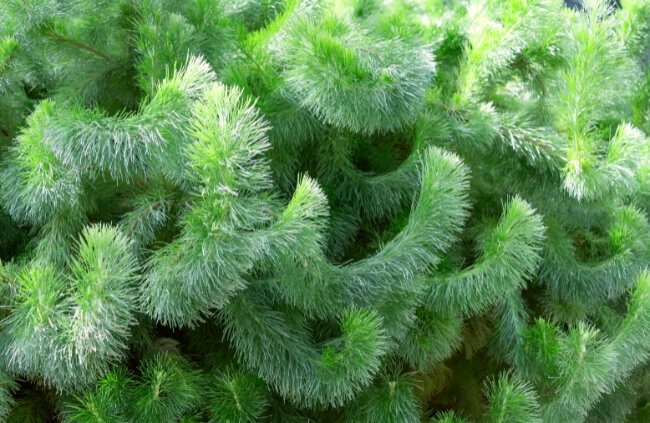
The woolly bush grows best in full sun, but in warm climates it can survive in partial shade. It has silky, silvery green foliage that is soft to the touch. Throughout the year, small red flowers will appear.
Woolly bush hedge plants require minimal pruning. Pruning is often performed to help the hedge keep its shape. The woolly bush grows best in rich, well-drained soil. It can tolerate salt and wind but does not do well in clay soil or wet soil.
Once established, it is drought tolerant. It needs frequent watering until it is established but once it does, watering about once a week when the soil is dry is enough.
In full sunlight, the woolly bush is fast-growing. Each bush can grow to be 5 m high by 1.5 m wide.
5. Korean Box (Buxus sinica var. insularis)
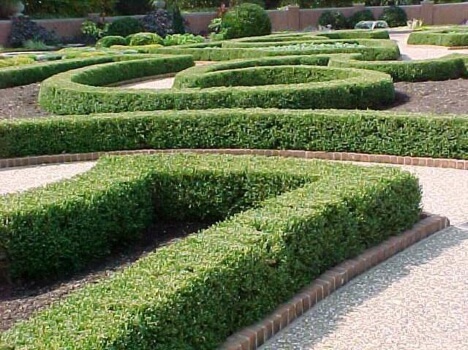
Source: Kiefer Nursery
The Korean box grows in full sun to partial shade. It has fine, dense foliage ideal for topiary gardens. The plant does not flower. Since the Korean box is a slow growing plant, it only needs pruning once to twice a year.
The pruning helps the hedging plants keep their shape while encouraging new growth. These hedge plants require rich, well-drained soil. If the ground gets waterlogged, they will not last long.
Once established, Korean box plants can survive drought periods. They only need low to moderate watering. Korean box plants are slow growing hedge plants. They can grow up to 1-2 m high by .5-2 m wide.
6. Lilly Pilly ‘Baby Boomer’

Source: Oxley Nursery
The Lilly Pilly ‘Baby Boomer’ grows in full sun to partial shade. It has mid-size, glossy green leaves with bronze new growth. The plant features fluffy white flowers and pink fruit. These hedge plants require regular pruning to encourage growth.
If left untrimmed, they will become unsightly and leggy. The Lilly Pilly ‘Baby Boomer’ thrives in rich, well-drained soil. It will not tolerate waterlogged soil. It needs moderate watering and can survive drought periods.
The hedging plants will grow fast in the right conditions. They are a shorter plant that only grows up to 1.5-2 m high by 1-1.5 m wide.
7. Sweet Viburnum (Viburnum odoratissimum)
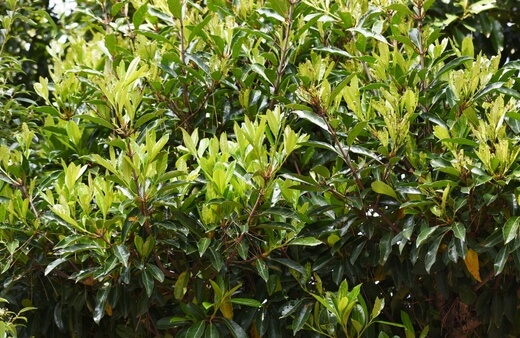
Sweet viburnum plants grow in full sun to partial shade. They have dark green, glossy foliage. The plants flower from the spring to summer and feature highly scented white to pink flowers.
The plants are tough and do not require much care. To help them keep their shape; you will want to prune them three to four times a year. Sweet viburnum can be planted in almost any type of well-drained soil, other than salty.
If the soil is too moist, the plants are prone to root rot and other diseases. Newly planted sweet viburnum must be watered frequently. Once the plants are established, they only need occasional waterings.
They can tolerate dry conditions. The easy to grow hedging plants are fast-growing and they establish quickly. They can grow up to 2-4 m high by 3 m wide.
8. Yuletide camellia (Camellia sasanqua)
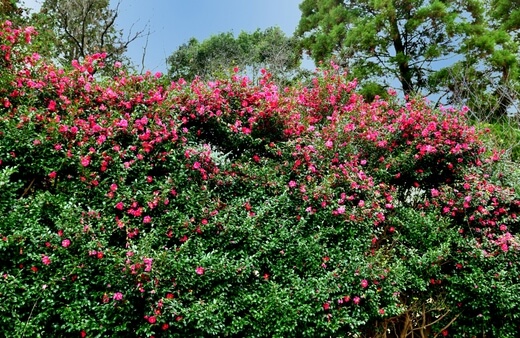
Camellia sasanqua are dense, upright plants that work wonderfully as hedging plants. They have glossy green leaves and bright red flowers with golden yellow stamens. The plants will grow in full sun to partial shade.
Camellia sasanqua only requires a single pruning in the spring for shaping. Pruning later will reduce flowering during the autumn. These beautiful plants must be planted in well-drained, organic rich soil.
They are a great plant for raised flower beds. It can take a full year for Camellia sasanqua plants to establish. During this time, the ground should be kept moist, but not over-watered.
Camellia sasanqua hedging plants are slow growers. They can grow up to 2 m high by 1 m wide.
Check out our in-depth guide to growing Camellia sasanqua for more info.
9. Japanese Box (Buxus microphylla var. japonica)
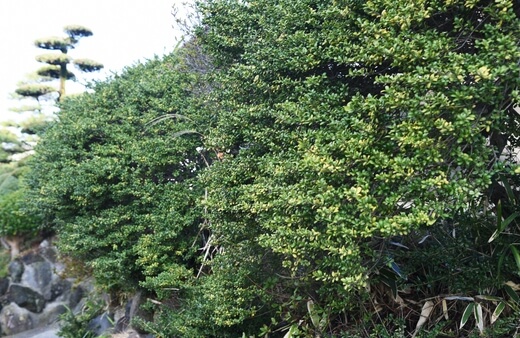
Perfect for shaping; the Japanese box is dense. It has dark green, oval shaped foliage and compact growth. The plants must be planted in full sun. The hedging plants only require pruning to keep their shape.
These plants can grow in almost any type of soil. However, they prefer humus rich loam. Once established, it needs minimal watering. If the ground gets too dry, the foliage will dry out and turn brown.
Japanese box plants have a moderate growth rate. They can grow up to 1-3 m tall by 1.5 m wide.
10. Green Island Fig (Ficus macrocarpa)

Source: Oxley Nursery
The Green Island Fig can grow in full sun to shade. It has small round leaves and dark red berries. It is a hardy plant that can be used as a low border or a tall hedge. Green Island Fig plants require one to two prunings a year. The hedging plants stay nice and compact with very little work.
These hardy plants can grow in different types of soil. But they do not like heavy soil in cold or wet climates. They do not tolerate extended periods of frost. The plants only have moderate watering needs.
Green Island Fig hedging plants have a moderate growth rate. They can grow up to 2 m high by 1.5 m wide.
11. Lilly Pilly ‘Straight and Narrow’
The Lilly Pilly ‘Straight and Narrow’ grows in full sun to partial shade. Its fine foliage is green with reddish new growth. The plant features lovely white flowers and pink fruit. These hedge plants need frequent pruning for maximum growth.
Without regular pruning, the Lilly Pilly ‘Straight and Narrow’ plants will grow into small trees. The hedging plants must be planted in well-drained soil. Planting the hedges in full sun with help to ensure they have dense foliage. They require moderate water.
Once established, they can tolerate short periods of drought. Syzygium ‘Cascade’ hedging plants will grow fast in the right conditions. They can grow up to 6-8 m high by 1-2 m wide.
12. Photinia ‘Robusta’

The Photinia ‘Robusta’ grows in full sun to partial shade. It has glossy dark green leaves with bright crimson new growth. The plant features dainty white flowers in the spring. Photinia ‘Robusta’ hedge should be pruned once or twice a year.
The first pruning should not be done until after the flowers have bloomed in the spring. These plants can grow in almost any soil that is well drained. While the plants are establishing, they need regular watering. Once established, only water during long dry spells.
The striking Photinia ‘Robusta’ grows fast. It is one of the most vigorous hedging plants you can grow. Each plant can grow up to 5 m high by 5 m wide.
13. Bay Tree (Laurus nobilis)

The Bay Tree can grow in full sun to partial shade. It has dark green, leathery leaves that are aromatic. The plant features star shaped yellow flowers and purple berries. The leaves and berries both have culinary and medical uses.
If planting bay trees as hedging plants, you must prune them regularly. If left alone, they will grow into trees. The bay tree grows best in well-drained, humus rich soil. It requires regular watering. Let the ground dry out before watering again. The roots do not do well if they get waterlogged.
Bay tree hedging plants grow very slowly. It can take anywhere from 10-30 years for them to flower and produce fruit. If left to grow they can reach 10-20 m in height.
14. Sweet Pittosporum (Pittosporum undulatum)
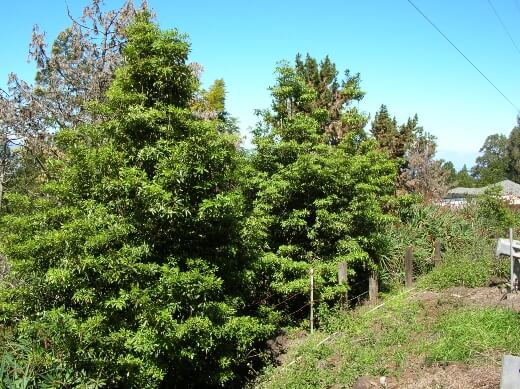
Source: PlantRight
The Sweet pittosporum requires full sun to grow. Its elliptical shaped leaves have a rich, glossy green colour. In the spring to summer months, the plant features fragrant yellow flowers and yellow to brown fruit.
These hedge plants need regular pruning. If they are not pruned regularly, they will grow into trees. The plants do best in rich, well-drained soil. The plants are drought-tolerant, but they do best with regular waterings. They are even able to handle water-logged soil for periods of time.
Sweet pittosporum hedging plants are fast-growing in most conditions. They can grow up to 12 m tall by 3 m wide.
15. Green Spartan (Juniperus virginiana ‘Spartan’)

Source: Garden Goods Direct
Green Spartan hedging plants should be planted in full sun. The plants have a rich green foliage that has a pine scent. They are extremely hardy plants that keep their conical shape as they grow.
Regular prunings are required to encourage dense growth and to shape. The plants need moist, well-drained soil. When establishing the plants, they should be watered every other day. Once established, do not over water. They do not tolerate waterlogged soil.
Green Spartan hedging plants have a slow to moderate growing rate. They can grow up to 6 m tall by 70 cm -1 m wide.
16. Photinia × fraseri ‘Red Robin’

The Photinia ‘Red Robin’ needs full sun to partial shade. It has deep green foliage with vibrant red new growth. The plant features creamy white flowers in the spring and berries like fruit.
Occasional prunings are required to maintain shape and promote new growth. The Photinia ‘Red Robin’ can grow in a wide range of soil types. Once established, it needs to be watered regularly.
Photinia ‘Red Robin’ is a fast-growing hedge plant. They can grow up to 6 m tall by 2 m wide. Hedges can be maintained to 2 m tall x 1 m wide.
Check out our comprehensive guide and start growing your own Photinia ‘Red Robin’.
17. Escallonia ‘Iveyi’
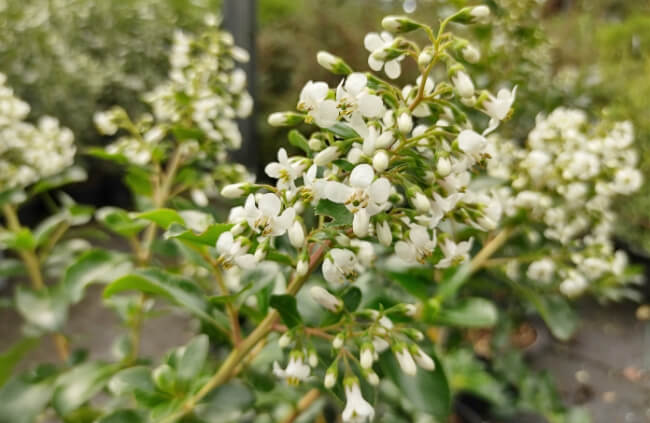
Escallonia grows in full sun to partial shade. It has glossy, dark green leaves. During the summer, it produces large clusters of fragrant white flowers. These hedge plants require minimal pruning.
Pruning should be done after flowering to promote new growth and additional flowers. These flowering hedge plants must be planted in well-drained, organic rich soil. Once established, they can even survive short drought periods. It will not tolerate waterlogged soil or extreme humidity.
Escallonia are fast-growing. They can grow up to 2.5 m tall by 2 m wide.
18. Coastal Rosemary (Westringia fruticosa)
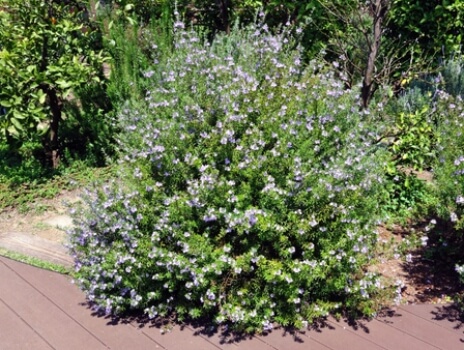
Coastal rosemary grows in full sun. Its foliage is dense, tight, and slender. The foliage can vary in colour from blues and greens to greys. During the spring and summer months, the plant features small white to light lilac coloured flowers.
Light, frequent prunings are needed to keep the plant tidy and encourage new growth. Coastal rosemary hedging plants must be planted in well-drained, organic rich soil. Once established, the plants are able to survive dry periods.
The evergreen hedging plants are fast-growing. They can grow up to 2 m tall by 4 m wide.
Find out more about this hedging plant with the help of our Westringia fruticosa growing guide.
19. Boxwood Hebe (Hebe buxifolia)
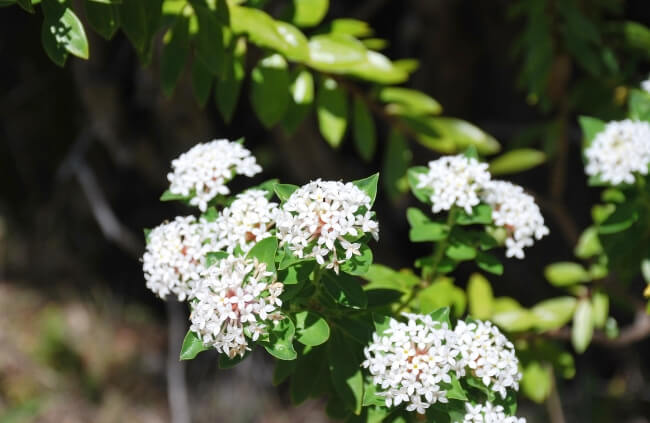
Hebe buxiflolia hedging plants grow in full sun to partial shade. They can have dark foliage and masses of white flowers. The boxwood hebe plants should be pruned after flowering. This will encourage new blooms in the next season. It keeps a fairly nice shape on its own.
These hedging plants can grow in most soils. Nevertheless, they prefer moist, well-drained, sandy soil. Once established, boxwood hebe plants can tolerate frost, wind, and coastal conditions. They require moderate watering after establishing.
Boxwood hebe hedging plants are fast-growing. They can grow up to 1 m high by 1 m wide.
20. Cupressocyparis leylandii ‘Leighton Green’
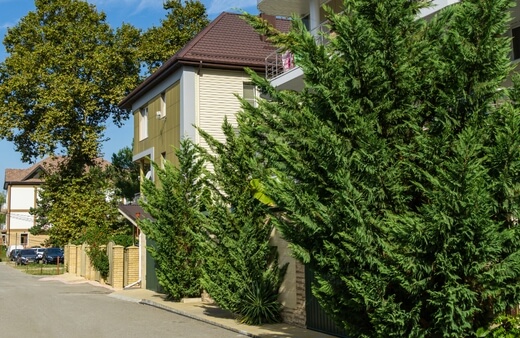
Cupressocyparis ‘Leighton Green’ are fast-growing hedging plants that are great for screening and blocking unwanted views. The plants have dense, fine dark green foliage. These hedging plants need regular prunings to keep their shape. Regular pruning will give you a tight, thick privacy hedge.
Cupressocyparis ‘Leighton Green’ favours well-drained soil. During dry periods, the hedges should be mulched and watered regularly. The plants are extremely hardy and can tolerate frost.
Moderate watering is required. Cupressocyparis ‘Leighton Green’ can grow up to 1 metre a year. They can grow over 20 m high by 10 m wide. To keep the hedging plants a manageable size, they must be pruned regularly.
Along with the mentioned list, don't forget to explore Nandina which is also an excellent choice for hedging. You can also grow privets for hedging but make sure to grow Ligustrum undulatum as this species is not invasive unlike other Ligustrum.
Below are our list of collections for different types of plants to choose from:
For more ideas, be sure to check out our YouTube videos. Whether you're looking for large hedges, small options, or fast-growing varieties, these will give you plenty of inspiration:
12 Best Large Hedging Plants for a Private Garden
10 Small Hedging Plants for a Neat and Tidy Garden
Fast Growing Hedging Plants for Quick Privacy: Top 10 Pick
Take Your Pick from the Best Hedging Plants to Grow in Australia
A beautiful hedge does not have to take a ton of work. And they can be a lot cheaper than installing a privacy fence. If you are thinking about installing a hedge, get busy planning now. Plan out your area and decide on which hedging plants are the right choice for your project.
Published on February 25, 2023 by Maisie Blevins
Last Updated on October 1, 2024

